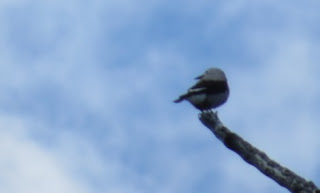It was spring break week back in 1992. I was a freshman in high school. I was fresh off my 500th bird in the fall of 1991. My dad Buddy would take me down to the Outer Banks of North Carolina for the week. We had a beach house there, that he would have to get ready for summer rental season. It was back then on April 21,1992 in Nags Head, NC that I saw my life bird Ruff. I don't remember any details, but it was in my book, so I'm sure dad made sure I saw that damn bird!!!
Fast forward 23 years later, and BOOM!!! A juvenile Ruff was spotted on Friday 25th at the north Hoover mudflats in Galena, OH. Two days later, the chase was on.
 |
| Ruff |
 |
| Philomachus pugnax |
 |
| taken from the boat |
Code-3: Rare.
Species that occur in very low numbers, but annually, in the ABA Checklist Area. This includes visitors and rare breeding residents. Mostly east coast and California coasts.
 |
| Juvenile |
 |
| Ring-billed Gulls, Greater Yellowlegs, Ruff in the middle |
The ruff is a migratory species, breeding in wetlands in colder regions of northern Eurasia, and spends the northern winter in the tropics, mainly in Africa-Senegal. The largest numbers breed in Russia (more than 1 million pairs), Sweden (61,000 pairs), Finland (39,000 pairs) and Norway (14,000 pairs). Of the various Eurasian shorebirds that stray into North America, this one is the most regular and widespread in its occurrence.
Gambill family history of seeing a Ruff:
My dad Buddy has his first observation on 4/10/1979 in Wooster, Ohio
Red & Louise have seen many through out their years of birding, I just don't have an exact date.























